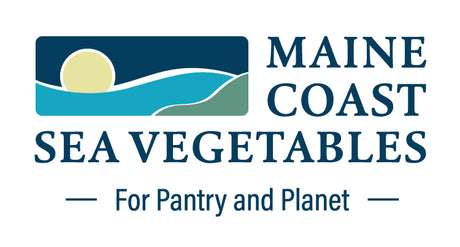Dulse (Palmaria palmata) has been prized by Maine Coast Sea Vegetable customers since we first offered it in the early 1980’s. Although some say dulse is an acquired taste, once acquired it’s with enthusiasm! Its complex flavor, deep red color, and soft chewy texture make dulse a ready to eat snack and a versatile ingredient in soups, salads, casseroles, or sandwiches, and smoked or fried dulse is delicious.
As seaweed becomes more popular, and dare we say it, mainstream, so too does dulse. Indeed, we now have to ration our dulse so we can continue to offer it to the broadest customer base possible. Understandably, this raises concern with some customers that dulse is becoming scarce in the Gulf of Maine, perhaps yet another victim of climate change or the loss of ocean life.
 Dulse likes to grow on rocks
Dulse likes to grow on rocks Thankfully, this is not the case. Dulse is still harvested from the same remote bays in the northern Gulf of Maine as when we started. The supply hasn’t changed, and neither has our commitment to sustainable practices in harvesting, processing and merchandising — leaving more than we harvest, producing more than we consume, and giving back more than we take. This means we can’t meet increased customer demand by simply harvesting more dulse from our traditional grounds; we would have to discover new grounds.
To understand why this is easier said than done, it helps to understand dulse ecology and harvesting.
Dulse is widely distributed in the cold waters of the North Atlantic and Arctic Oceans, but it’s also found in warm temperate waters as far south as New Jersey in the Western Atlantic and along the coasts of Portugal and Spain. This shows that dulse may continue to thrive even as the Gulf of Maine and the North Atlantic grow warmer in coming decades. Throughout much of its range dulse is found as an epiphyte, meaning it grows attached to other plants, but not as a parasite. Picture a fern growing on a tree trunk. In many other places, though, dulse is epilithic, meaning it grows on rocks, similar to moss but with wavy fronds. However, despite its wide distribution, dulse is rarely found growing in beds thick enough to economically harvest.
Only a few places in the world have the right combination of tides, wave action, rocky beaches, and unique ecological conditions to grow dulse in abundance. In particular, epilithic dulse seems to best thrive on fields of boulders that are just the right size…neither too large nor too small.

Dulse harvesting takes a strong back
Even when these conditions are met and dulse grows in abundance, there have to be harvesters nearby willing to undertake the hard work of bringing it to market. Most dulse is hand-harvested from a few special places in Ireland, Spain, Iceland, and the Bay of Fundy in the northernmost Gulf of Maine. Harvesting occurs from late spring until about November.
A good time to harvest is when the tides are at their lowest, which happens when the moon is either new or full. These are known as drain tides. The best dulse is found low in the intertidal zone, and harvesters want to have at least two hours before the rising tide once again covers the beds. This might mean awakening at 3 AM to scramble about on slippery boulder fields under the light of the moon, or with no light at all but a torch!
The fronds are firmly grasped and pulled away with a gentle tug, while always being careful to leave the holdfast and some vegetation behind for regrowth. The harvested dulse is then spread over netting on specially prepared fields of clean rocks for six to eight hours for solar drying. During periods of fog or rain, the dulse may be stored at the edge of the tidal zone in burlap sacks for up to a week until the sun returns.

Dulse laid out for solar drying
Together, ecology and harvest combine to make dulse a very special seaweed. Although it’s abundant and widespread, it’s rarely found in enough abundance in any one place to support more than a few traditional fisheries. These fisheries have sustained coastal communities for generations. As demand for dulse grows, we must take care to protect both the resource and the fishing communities that rely upon it as a source of income.
There may yet be undiscovered dulse beds awaiting harvest, and someday farmers may grow dulse in the sea or in tanks. But until then, we hope our customers understand that they may not always be able to buy as much dulse as they would like.



